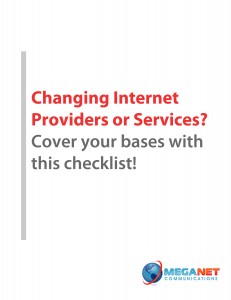Businesses are reliant on their Internet connections to conduct business every day. Over time, many businesses may outgrow their connection and opt to move to a faster or more reliable service; or, in some unfortunate circumstances businesses may need to downgrade due to budget issues.
One thing we always try to do is talk to businesses so we can determine exactly what their needs are, and then make some recommendations based on those needs. Sometimes the client will ask us why we didn’t recommend a specific type of service, and it’s usually due to one of two reasons – either it won’t fit their needs/budget, or it’s just not available to their office.
Here are the most popular types of Internet access services we can offer to clients in our coverage area, and why they might not be available to everyone.
DSL – DSL service is probably the most affected service offering when it comes to availability based on location. Because it’s distance specific, some locations aren’t able to qualify for DSL service due to the location’s distance away from the equipment that serves it. If your office or home is located more than 18,000 feet away from the telco equipment that offers DSL, unfortunately it won’t be able to be delivered. Also, the speed options decrease as the line distance increases, so a building that’s 15,000 feet away from the DSL equipment will not be able to get all the speed options that a business that’s 5,000 feet away can get.
Ethernet over Copper – Much like DSL, Ethernet over Copper is also distance specific; offices that are further away from their local telco Central Office may not be able to qualify for all Ethernet over Copper speeds. Also, like DSL, if a business is too far away from the Central Office, the service might not be available at all. Usually a quick pre-qualification can be done to determine if it’s available or not. Since Ethernet over Copper is a relatively newer service offering, not every city/town can support it. New equipment is being rolled out, so it will become more widely available over the coming years.
Metro Ethernet – Fiber based services aren’t reliant on distance like some copper products such as DSL are, so that doesn’t come into play when a business is considering Metro Ethernet. What does come into play is the availability of fiber to the building, and if the local Central Office supports Metro Ethernet. We’ve only seen a few isolated instances where Metro Ethernet wasn’t available in that case, thankfully. What most businesses need to consider is how long it will take to deploy fiber to their location, and the associated costs. Most larger cities such as Boston, Cambridge, Providence, and Hartford have wide fiber rollouts, so often installation is a matter of running fiber into the customer’s building from the pole just outside their office. Smaller cities might find businesses needing to have fiber run down their street, or extended down some telephone poles in order to deliver it to their building. This results in a longer installation timeframe and higher one-time install costs, but it can be delivered.
T1 – T1 service is delivered over copper like DSL, however it’s a special type of digitally-conditioned copper so it’s available pretty much anywhere, with no limitations on speed or performance. We’ve often joked over the years that if a business has phone service, then they can get a T1 line, even if they’re in the middle of a swamp. Of course, we ending up installing a T1 to a business that was located… you guessed it, in the middle of a (filled in) swamp. Headed into 2014, T1 Internet access is starting to be viewed as a service that’s been replaced by a few others when it comes to performance and reliability, however it’s available everywhere, and it’s low latency/high uptime still make it a very viable option for businesses that don’t qualify for some other types of Internet access.
There are other non-telco based services such as cable and fixed wireless that also have availability concerns; with cable it’s whether or not facilities/wiring are available and with fixed wireless it is often a spectrum licensing or line of sight issue that can impact availability. Again, usually a location pre-qualification or a site visit can determine service availability, and how the customer’s location can impact installation times and costs.
Of course, even more so than availability, the customer’s needs are primary to whether or not a specific service is the best fit for them. A company with 100 employees that are heavy Internet users isn’t going to be best served with DSL Internet access, likewise a small office with 5 employees that only use the Internet to check email and do periodic research isn’t going to require a Metro Ethernet fiber rollout.
In the end, it’s always best to talk with your Internet provider about your specific needs and see what available services would make the most sense and provide the best fit.
Is your business considering changing it’s Internet access for better speed or performance? Or are you perhaps thinking about changing providers to improve your uptime or costs? Download our free Internet Service Provider Change checklist to make sure your company is fully prepared to change your service or provider with ease and minimal service disruption.

